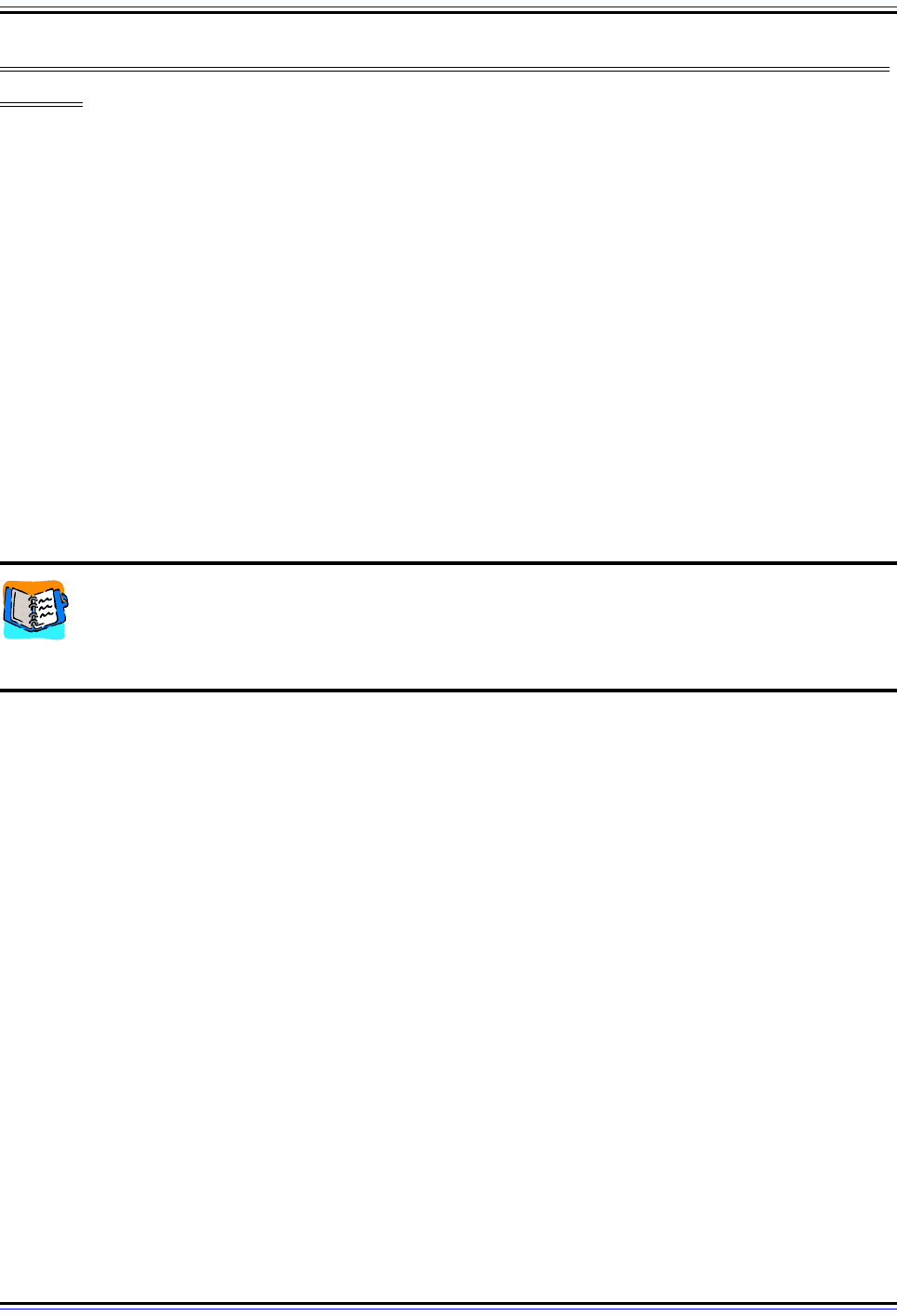Charles M. Kozierok The TCP-IP Guide
Подождите немного. Документ загружается.


The TCP/IP Guide - Version 3.0 (Contents) ` 961 _ © 2001-2005 Charles M. Kozierok. All Rights Reserved.
This is the complement of broadcast name registration, of course. It too can only be used in
simple systems where every device can hear a broadcast. The use of broadcasts also
makes it wasteful of network bandwidth.
Client/Server Name Resolution
Servers are programmed with software that allows them to respond to name resolution
requests sent by clients. These servers take the name in the request, look up the
associated numeric identifier in a database, and send it back in a response.
This technique is, of course, generally used in conjunction with database name registration.
It is the most complex of name resolution methods, but is also the most efficient, and the
only one that can really work properly on a large, distributed hierarchical name system.
Client/Server Resolution Functional Elements
The last of these three methods is the one used for most large, modern name systems. The
client/server method of request/reply resolution is similar to how many other protocols
function. One thing that is unique about name resolution, however, is that name resolution
isn't often invoked directly by the client. It's rare, for example, for a human user to say
“please resolve the following name”. We also certainly wouldn't want a user to have to
manually resolve a name to an address each time they wished to contact a device, as this
would be cumbersome.
Instead, the system is automated by having software accept machine names input by
users. The software resolves the name by passing it to a name resolver software
component. The resolver acts as the client in the name resolution process. It contacts a
name server, which responds to the request. The name resolver and name server
constitute the two main functional elements in name resolution.
In a distributed database for a hierarchical name system, multiple requests may be
required, since name servers will contain only information for certain machines and not
others. Resolvers follow a special procedure to “travel” the hierarchy until they find the
server that has the information they want. Again, TCP/IP's Domain Name System (DNS)
name resolution is the best example of this method.
Key Concept: Name resolution is arguably the most important of the main functional
elements of a name system, because it is the part of the system that actually
converts names into addresses. The two main components of name resolution are
name resolvers, which act as clients in the resolution process, and name servers. The three
main name resolution methods—table-based, broadcast and client/server—correspond
closely to the table, broadcast and database methods of name registration.

The TCP/IP Guide - Version 3.0 (Contents) ` 962 _ © 2001-2005 Charles M. Kozierok. All Rights Reserved.
Efficiency, Reliability and Other Name Resolution Issues and
Features
In the preceding topic I described the primary function of name resolution: allowing humans
to identify devices using names, then converting these names into numbers so that
computers can use the numbers instead. This basic task is conceptually quite simple, but it
can become quite complex in implementation. The reason for this is the key characteristic
that makes name resolution so different from the other tasks performed by a name system:
the frequency with which it is done.
Name registration is seldom done, but name resolution is done very often. If you consider a
large internetwork with thousands of users running various applications, millions of names
must be resolved every day. Now, consider something like the Internet, which must process
billions of client/server requests and replies daily! Ensuring that such systems work requires
that we do more than just implement a resolution process; we must add facilities to ensure
that resolution is done as effectively as possible.
Efficiency Considerations
The first major concern with name resolution is efficiency. Name resolution uses up system
resources, especially with resolution techniques that require requests and replies to be
sent. This means we want to minimize the number of times resolution is performed, if at all
possible. Now, consider that many people will frequently access the same machines over
and over again. For example, if you go to a Web site called “www.thisisasite.com” for the
first time, your system will need to resolve that name. After the home page for that site
loads, if you click a link to another page on that site, the page will also be found at that same
name: “www.thisisasite.com”. It would be wasteful to then have to resolve the name a
second time.
To avoid this, name systems almost always include some sort of caching capability, which
allows devices to remember recent name resolutions and retain the mapping from name to
address for a period of time. Whenever a name needs to be resolved, the cache is first
checked before going through the formal process of resolution. The use of caching elimi-
nates the vast majority of actual name resolution requests that would otherwise be required.
The drawback of caching is that it requires some system resources of its own, and that it
adds complexity to the system. One issue is deciding how long to retain data in the cache; if
we keep it too short a time, we generate extra unnecessary resolution requests; keep it too
long, and we risk having the mapping become “stale” if the name assignment for the
machine changes. These are issues that a sophisticated name system must deal with. A
typical solution is to allow each name registration to specify how long information about that
name-to-address link may be cached.

The TCP/IP Guide - Version 3.0 (Contents) ` 963 _ © 2001-2005 Charles M. Kozierok. All Rights Reserved.
Reliability Considerations
The main concern with name resolution after efficiency is reliability. As I said earlier in the
section, having a name system isn't strictly necessary for the computers, but it's very
important for the users, especially on a large network like the Internet. While having a single
central place that maintains all information about a name system may make administration
simpler, it creates a dangerous “single point of failure”. If anything happens to the device
storing the information, the entire name system fails.
Modern name systems employ redundancies to prevent having the entire system rely on
any particular device for resolution. A typical approach in a client/server system is to have
multiple servers in different locations (or attached to different networks) that can respond to
name resolution requests.
Key Concept: Since name resolution is the part of a name system that is used most
often, it is here that we must pay careful attention to implementation issues. The two
most important ones are efficiency and reliability. Efficiency is essential due to the
many thousands or millions of resolutions performed every day on a large system; reliability
is a consideration because users of the name system quickly come to rely on it and we
must make sure it is robust.
Other Considerations
An optional feature in some name resolution systems is load balancing. When properly
implemented, load balancing allows a single name to map to more than one underlying
address. This allows requests sent to a particular “virtual” device to actually be directed to a
number of different actual physical devices, spreading the load over multiple machines. A
common use of this feature is for very popular, heavily-trafficked Web sites.
Finally, while name resolution is obviously designed to allow names to be mapped into
addresses, there are cases where we may wish to go in the other direction: given a numeric
address, find the name that goes with it. This process, called reverse resolution, is
analogous to having a phone number and trying to find the name of the person or company
to which it belongs. Just as we can't easily find the name matching a phone number using a
conventional phone book (we'd have to scan every page looking for the number), reverse
resolution requires special support on the part of the name system. This is especially true if
the name system data is distributed over many servers.

The TCP/IP Guide - Version 3.0 (Contents) ` 964 _ © 2001-2005 Charles M. Kozierok. All Rights Reserved.
TCP/IP Name Systems: Host Tables and Domain Name System
(DNS)
The TCP/IP protocol suite is the most widely used in networking today. TCP/IP has become
sufficiently popular that many people—even non-geeks!—are fairly comfortable working
with its numeric identifiers (IP addresses). Even so, it's a lot easier to work with names than
numbers, and it's certainly easier to remember them. We can consider also that name
systems become more important when used on larger networks than smaller ones, and that
TCP/IP is used to implement the Internet, the world's largest internetwork. Having a good
name system is vital to the operation of the Internet, and thus, has become an important
element of TCP/IP as a whole.
In this section I describe the name systems used in TCP/IP. I begin with an overview of
device naming in TCP/IP, including a discussion of the history of how device naming began.
I then describe the two different name systems that have been used in TCP/IP: the simple
host table name system, and the modern Domain Name System (DNS). Far more detail is
included on the latter than the former, since DNS is both much more complex than host
tables, and also more widely used in today's networks.
Background Information: This section assumes that you are already familiar with
the general concepts and issues of name systems explained in the preceding
section. Reference is made to descriptions of name system components and
methods where appropriate.

The TCP/IP Guide - Version 3.0 (Contents) ` 965 _ © 2001-2005 Charles M. Kozierok. All Rights Reserved.
Overview and History of TCP/IP Host Names and Name Systems
In the section that introduces name systems and describes the concepts behind them, I
described an interesting paradox. Even though name systems aren't strictly necessary for
the functioning of a networking system, they make using a network so much easier for
people that they are considered an essential part of most networks. I think no better
evidence of this can be found than the history of name system development in TCP/IP.
Early Use of Host Names on the ARPAnet
In fact, the history of name systems in the TCP/IP protocol suite actually goes back well
before TCP and IP were themselves even created! In the late 1960s and early 1970s, when
the predecessor of the Internet (the ARPAnet) was being developed, it used older
networking protocols that served the same function that TCP and IP do today. The ARPAnet
was very small by today's standard, containing at first only a few machines, called hosts just
as TCP/IP machines often are today. The addressing scheme was also very simple: just the
combination of an IMP (computer) number and a port number for each host.
With only a handful of machines names it was easy to memorize addresses, but as the
ARPAnet grew to several dozen machines this became untenable. As early as 1971, it was
apparent to the engineers designing the ARPAnet that symbolic names were much easier
for everyone to work with than numeric addresses. They began to assign simple host
names to each of the devices on the network. Each site managed its own host table that
listed the mappings of names to addresses.
The First ARPAnet Name System: Host Name Lists
Naturally, the ARPAnet engineers immediately recognized the dangers of having each site
maintain a list of possibly inconsistent host names. Since the internetwork was just a small
“club” at this point, they used the RFC process itself to document standard host name to
address mappings. RFC 226, Standardization Of Host Mnemonics, is the first RFC I could
find showing how host names were assigned. It was published on September 20, 1971.
This initial name system was about as manual as a system could be. As additions and
changes were made to the network, the list of host names was updated in a new RFC,
leading to a series of RFCs being published in the 1970s. Each host administrator still
maintained his or her own host table, which was updated when a new RFC was published.
During this time, the structure of host names was still under discussion and changes were
made to just about every aspect of the name system as new ideas were explored and
refined.
This worked fine while the ARPAnet was very small, but had many problems. One was that
it was extremely slow in responding to network modifications; additions or changes would
only be entered into device tables after a new list was published. Even with the centralized
list, there were also still potential consistency issues, if a site manager forgot to update a file
or made a typographical error. These were in addition to the usual limitations of a host-
table-based name system.

The TCP/IP Guide - Version 3.0 (Contents) ` 966 _ © 2001-2005 Charles M. Kozierok. All Rights Reserved.
Storing Host Names in a Host Table File
The first improvement was to make the list of host name assignments a standard “master”
text file that would be centrally managed and could be downloaded using network protocols
like FTP. The file was maintained at the Network Information Center (NIC) at Stanford
University. The process for defining and using this file was described in RFCs 606 and 608,
both entitled Host Names On-line, published in December 1973 and January 1974 respec-
tively. These documents also formally specified the syntax for the TCP/IP host table name
system.
The use of a centrally-managed host table continued through the 1970s. When TCP/IP was
developed the system was maintained, and mappings made between host names and 32-
bit IP addresses. RFC 810, DoD Internet Host Table Specification
, shows how host tables
were defined for use with IP addresses. It was published in 1982.
Outgrowing the Host Table Name System and the Transition to DNS
It was at around this same time that continued growth of the ARPAnet/Internet made it
apparent that the simple host table name system would eventually become unmanageable.
With at first dozens and then soon hundreds and thousands of new hosts connecting to the
internetwork, a single text file maintained in a central location just wasn't up to the task, for
a variety of reasons.
The idea of moving to a hierarchical name system based on the concept of domains was
first introduced in 1981 in RFC 799, Internet Name Domains
. Considerable discussion and
development of this concept occurred in the early 1980s, and by 1983 a plan was put in
place to migrate from the flat host table name system to the new Domain Name System
(DNS). The detailed history of the development of this name system is continued in the
overview section on DNS.

The TCP/IP Guide - Version 3.0 (Contents) ` 967 _ © 2001-2005 Charles M. Kozierok. All Rights Reserved.
TCP/IP Host Table Name System
The pioneers of the modern Internet made the first name system for the suite when they
created simple files containing the names and addresses of the machines in the early
ARPAnet. This system was so simple that it originally wasn't even formally specified as a
“name system” per se. Since the files contained names for network hosts, the process for
relating names to addresses was simply called the “host name” mechanism. Later, these
files were called host tables, and for this reason I call this technology the TCP/IP host table
name system.
As a system, it is extremely simple, since it consists of nothing more than a text file
maintained on each machine on the network. This file is normally called “/etc/hosts” on a
UNIX system, or HOSTS on a Windows system (usually residing in the main Windows
directory). The file usually begins with some comment lines and then lists pairs of IP
addresses and host names. A very simplified example (using the modern table structure,
which is slightly different than the original host table format) is shown in Table 162.
Host Table Name Space
The name space and architecture for this system is theoretically flat, with each name being
able to take any form without any real structure. Despite this, certain rules were eventually
put in place regarding how names should be created, for consistency. As we will see later in
this topic, it's also possible to use host tables to support the implementation of a hierarchical
name space, which would obviously mean the names would have to be created using that
name space’s structural rules.
Host Table Name Resolution
Name resolution in this system is very simple. Each device reads the host table into
memory when it starts up. Users of the system can make reference to the names in that
host table in their invocation of various applications, by using a name instead of a numeric
IP address. When the software detects a name has been used in this manner, it refers the
Table 162: Example TCP/IP Host Table
# Host Database
# This file should contain the addresses and aliases
# for local hosts that share this file.
#
# Each line should take the form:
# <address> <host name>
#
127.0.0.1 localhost
209.68.14.80 www.pcguide.com
216.92.177.143 www.desktopscenes.com
198.175.98.64 ftp.intel.com

The TCP/IP Guide - Version 3.0 (Contents) ` 968 _ © 2001-2005 Charles M. Kozierok. All Rights Reserved.
name to the internal resolver routine in the device, which looks up the name in the host
table in memory and returns its address. There is no need for any transmissions or servers
to be contacted; resolution is entirely local.
Host Table Name Registration
Now, here is the part where I am supposed to say that name registration in the host table
name system is simple as well, right? Well, yes and no. From a purely technical standpoint
it certainly is: a name is “registered” on a particular device when the name and corre-
sponding IP address is entered into the device's host table, and that's it.
However, name registration is much more complicated from an administrative standpoint,
and this is in fact where we find the major weakness of using host tables. Each network
device maintains its own host table independent of the others, usually stored as a file on its
local hard disk. This is in contrast to database registration systems where the data is
centrally stored and managed. This leads to two very important concerns:
☯ Consistency: Since every device has its own host table, how do we ensure that infor-
mation is consistent between all the tables on the different devices?
☯ Modifications: How do we ensure that information about new device mappings, or
changes to existing ones, is propagated to all devices?
The original mechanism for this was simply hand-editing, with administrators consulting
updated published lists of device names. This was a very inefficient method that was prone
to error and slow to acknowledge changes to the network. The revised system used a
centrally-managed “master” file that was downloaded by all sites on a regular basis. Name
registration in this method required that the name/address mapping be submitted to the
authority managing the central file, the Network Information Center (NIC).
Weaknesses of the Host Table Name System
The use of a centralized master file for name registration certainly worked better than using
the equivalent of “inter-office memos” to publish host name lists, but was itself only practical
in the early days of TCP/IP. As the internetwork grew larger, the weaknesses of the host
table system grew:
☯ Central Administration Overload: The changes to the central file became more
frequent, increasing the administrative load on the individual managing the “master”
file to the point where changes were being made many times per day. As the Internet
continued to grow, it would eventually have been impossible for a human being to
enter the changes as fast as they were being submitted.
☯ Growth In Size Of the Master File: Every host needed a line in the master file. When
the Internet grew to be thousands and eventually millions of devices, the file size
would have become excessive.

The TCP/IP Guide - Version 3.0 (Contents) ` 969 _ © 2001-2005 Charles M. Kozierok. All Rights Reserved.
☯ Excessive Bandwidth Use: Since the file was changing so often, this also meant that
all the devices on the network had to keep downloading this master file repeatedly to
stay current. At the same time, the file was also growing in size as just mentioned. The
combination of many downloads of a large file meant large amounts of network
bandwidth were being consumed on something that is, in essence, an overhead
activity.
☯ Flat Namespace Problems: The lack of a hierarchical name space led to conflicts
when users chose identical names for their devices, and this further increased the
workload on the central administrator. These issues were ameliorated in part by using
naming conventions, such as using a prefix with a location before each individual
machine name, but this was not an ideal solution.
All of these are reasons why the designers of the Internet eventually moved away from
using host tables for the entire Internet to the more capable Domain Name System (DNS).
Key Concept: The host table name system was the original mechanism used for
implementing names on the early Internet. It consists simply of a set of tables
containing mappings between names and addresses maintained on each machine in
the internetwork. When a name needs to be resolved the table is consulted to determine the
appropriate address. This system is extremely simple, but not very capable, and not well-
suited to a large global Internet, which is why it was eventually abandoned in favor of DNS.
Use of the Host Table Name System In Modern Networking
That said, the host table name system has not gone away entirely. There are two circum-
stances in which this technique is still of value:
☯ Small “Island” Networks: If you are setting up a small local area network using TCP/
IP, and you don't need the names of your devices to be accessible by those outside
your network, then guess what? You have the equivalent, of sorts, of the early Internet,
and the host table system is as applicable to you as it was to the Internet in the 1970s.
You can simply set up host tables on each device and manage them manually. As long
as the LAN is small enough that editing these files periodically is not a hassle, this is
actually a fast and effective name system, because no exchange of messages is
needed for resolution. You can even maintain a master file on one machine and copy it
to the others when changes are required using a script, to save time.
☯ Providing Local Name Mappings To Supplement DNS: Even though modern
systems use DNS for most name resolution, they also usually still support the use of
host table files. You can manually enter common name mappings into this file, even for
devices that are on the global Internet. Your system can then be set up to consult this
list before making use of its assigned DNS server.
The use of the HOSTS file in conjunction with DNS allows you to manually specify
mappings for commonly-accessed sites, which may provide a slight performance
improvement since there is no need to access a server. Since the HOSTS file doesn't

The TCP/IP Guide - Version 3.0 (Contents) ` 970 _ © 2001-2005 Charles M. Kozierok. All Rights Reserved.
enforce any particular structure to names, it is naturally quite possible to put DNS-style
hierarchical names into the file, as I showed in Table 162. The file is loaded into memory
and used to override the normal DNS process for names listed in it.
Of course, you then subject yourself to all the potential maintenance headaches of
manually-edited files: you must update these files as host names or addresses are changed
in the DNS system. For this reason, this second use of the HOSTS file for Internet sites
served by DNS is less popular than the use of the file for local machines.
Key Concept: Even though the host table name system is not the primary
mechanism used for TCP/IP naming, it still used in two circumstances. The first is to
implement a basic name system in a small local TCP/IP internetwork.The second is
as an adjunct to DNS, where it allows manual mappings to be created that override the
DNS process when needed.
